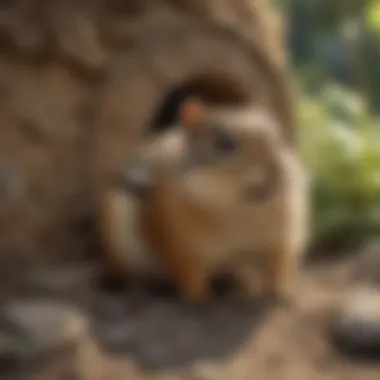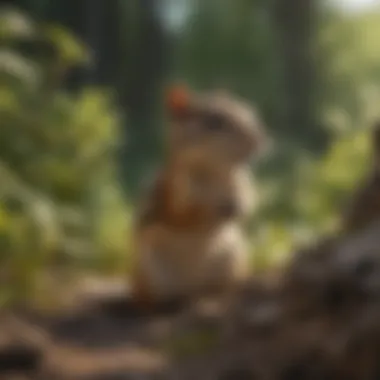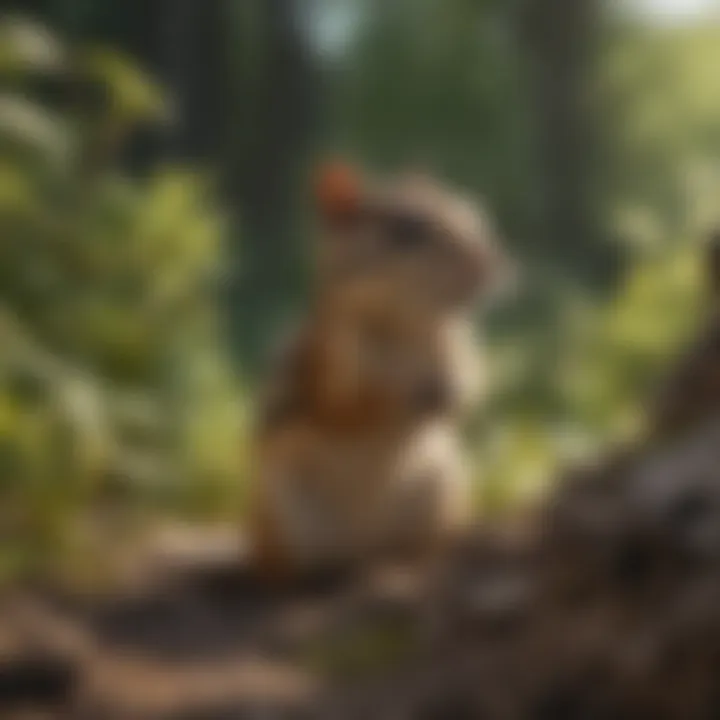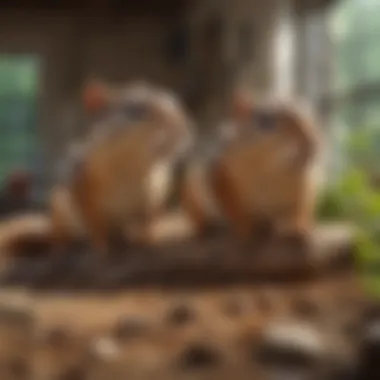Understanding Chipmunks in Home Environments


Intro
Chipmunks are small, striped rodents that often inhabit suburban areas, making them frequent visitors to residential spaces. While their presence may seem harmless, it can lead to several challenges for homeowners. Understanding the behaviors and environmental needs of chipmunks is vital for minimizing possible conflicts between humans and these animals. This article delves into the factors that bring chipmunks into homes, their behavior, associated risks, and ways to effectively manage their presence.
Understanding Pests
Definition of Pests
In the context of housing environments, pests are organisms that negatively affect human habitation or well-being. Chipmunks fall into this category when they invade spaces intended for human use, such as gardens, attics, or basements. They may cause damage to property and disrupt the balance of local ecosystems.
Importance of Pest Identification
Correct identification of pests is crucial for effective management strategies. Chipmunks are often mistaken for less benign pests. Their tendency to dig burrows can undermine the structural integrity of gardens, and they may consume plants or stored food. Identifying them correctly ensures that homeowners adopt appropriate measures for control and prevention.
Prevention Techniques
Home and Garden Preventative Measures
To prevent chipmunks from entering homes, several proactive strategies can be implemented:
- Seal Entry Points: Inspect foundations, vents, and attics for holes or cracks. Seal any with appropriate materials to block access.
- Reduce Food Sources: Keep outdoor areas clean. Secure trash cans, remove pet food, and clean fallen fruits or nuts from the ground.
- Maintain Landscapes: Trim dense shrubbery and remove brush piles that could serve as habitats for chipmunks.
Seasonal Prevention Tips
Chipmunk activity can vary seasonally. Taking specific actions during particular times of the year can enhance prevention efforts. During autumn, ensure that all potential entry points are sealed as chipmunks seek warmth for winter. In spring, consider revisiting garden layouts to minimize attractive food sources.
Eco-Friendly Pest Control Solutions
Overview of Sustainable Practices
Employing eco-friendly methods to manage chipmunk populations not only minimizes environmental impact but also promotes coexistence. Non-lethal deterrents, like planting specific herbs, can discourage these rodents from frequenting gardens.
Natural Remedies and Their Effectiveness
Natural repellents may prove beneficial. Some homeowners have found that using oils, such as peppermint or eucalyptus, can deter chipmunks when applied around the perimeter of gardens. Effectiveness varies among households, requiring a trial and error approach to discover what works best in a specific environment.
"Preventative measures can greatly reduce the chances of chipmunks causing disturbance in household environments."
In summary, understanding the behaviors and needs of chipmunks is an essential aspect of managing their presence in housing environments. By implementing proactive strategies and eco-friendly solutions, homeowners can coexist more peacefully with these small creatures.
Prelude to Chipmunks
Understanding chipmunks is essential for homeowners who want to minimize their impact in living areas. This section highlights the relevance of recognizing these animals, their habits, and the challenges they pose. Chipmunks are more than just cute creatures; they can affect home environments significantly. Knowledge of their behavior and preferences can aid in developing effective prevention strategies.
Overview of Chipmunk Species
Chipmunks belong to the family Sciuridae, primarily identified by their distinct stripes and small size. The Eastern chipmunk is one of the most common species found in North America. These small mammals are generally about 9 to 10 inches long, including the tail. For many, they are a common sight in gardens and parks.
The overall population is diverse, but local adaptations can be seen in different environments. Chipmunks are mostly terrestrial, meaning they prefer to live on the ground rather than in trees. This behavior influences how they nest and forage. Understanding what kind of chipmunks inhabit your area can provide insight into their habits. Knowledge of these species can guide how to manage their presence effectively.
Habitat Preferences
Chipmunks prefer habitats that offer a blend of cover and food sources. They thrive in wooded areas, gardens, and even residential landscapes where they can find shelter and forage safely. Their ideal environment includes rocks, underbrush, and fallen logs, which provide hiding spots from predators.
In urban settings, they often take advantage of gardens with plentiful seeds and nuts. Homeowners may find these habitats attractive to chipmunks, potentially leading to increased activity in their yards. Here are some common habitat features that chipmunks look for:
- Shelter: Rock piles, dense shrubs, and adequate ground cover are vital for nesting.
- Food availability: Nut-bearing trees and bird feeders can attract chipmunks, encouraging them to stay nearby.
- Water sources: They need water, which could come from ground moisture or bird baths in gardens.
It's essential to consider these preferences when designing landscapes. Understanding what attracts chipmunks may assist in reducing their population in residential areas.
Behavioral Traits of Chipmunks
Understanding the behavioral traits of chipmunks is crucial for homeowners. These small mammals exhibit unique behaviors that can help us understand their presence in our living spaces. By recognizing their habits, we can better manage interactions and minimize potential issues. Key elements of their behavior include their dietary habits, communication patterns, and territorial tendencies. Each of these traits influences how they interact with their environment and, by extension, human dwellings.


Dietary Habits
Chipmunks have omnivorous diets, primarily consisting of seeds, nuts, fruits, and insects. They are known to store food for the winter months, which can lead them to search for food sources in residential areas. The convenience of human-created feeding grounds, such as bird feeders or compost piles, often attracts them. This behavior, though instinctual, can create challenges for homeowners, as it encourages chipmunks to enter houses looking for easy meals.
Chipmunks can consume a wide variety of food, making them opportunistic feeders.
Being aware of their dietary preferences can allow homeowners to secure food sources. Simple steps like cleaning up fallen seeds and keeping pet food indoors can reduce chipmunk activity. Understanding their feeding habits is essential for reducing the attractiveness of a home to these animals.
Social Structure and Communication
Chipmunks usually lead solitary lives outside of mating season, but they are social animals in their own way. They communicate through a range of vocalizations, which can include chattering and chirping. These sounds convey important messages, such as alerts to danger or signals to other chipmunks about territory. Observing these interactions can provide insight into their presence around homes.
Knowing their communication patterns can help inhabitants of a home recognize when a chipmunk is nearby. Also, when chipmunks feel threatened, they may respond with visible displays of aggression or retreat to their burrows. Maintaining those burrows is critical for their survival, and the local population of chipmunks often reflects the health of the ecosystem.
Territorial Behavior
Territorial instincts are a prominent aspect of chipmunk behavior. They are known to establish and defend their territories against other chipmunks, which minimizes confrontations but creates the need for clear markers. Chipmunks will often dig to create burrows, which they claim as their own. These burrows can sometimes lead them into the foundations of homes or landscaping. Recognizing the signs of territorial marking, like digging or droppings, can assist homeowners in identifying where chipmunks may be living.
By knowing that chipmunks have specific territorial behaviors, people can take proactive measures to create less inviting environments. This can include sealing off potential points of entry and monitoring the yard for signs of their presence.
In summation, a deeper understanding of basic chipmunk behaviors provides essential insights for homeowners. Recognizing their dietary habits, social structures, and territorial instincts serves as a foundation for effective management strategies regarding these animals.
Reasons for Chipmunks Entering Houses
Chipmunks are small creatures that often find their way into homes for a variety of reasons. Understanding these motives is crucial for homeowners who wish to manage their presence effectively. Chipmunks are part of a natural ecosystem and their behaviors can sometimes clash with human living environments. Knowing why they enter houses can help mitigate potential problems while respecting wildlife needs. This section delves into three main factors, namely food sources, shelter and safety, and seasonal behavior patterns, which collectively explain the reasons behind their intrusion.
Food Sources
Chipmunks have a varied diet, primarily consisting of seeds, nuts, fruits, and insects. They are opportunistic feeders, which means they often seek food wherever it is available. In households, they are attracted to easily accessible food sources. This may include dropped seeds from birdfeeders or uncovered trash bins. Pet food left outside is another common attractant.
Homeowners should be aware of the potential food sources that can attract these rodents into their living spaces. Ensuring that food is stored in sealed containers can reduce their chances of entering. Additionally, keeping outdoor areas clean and free of food debris is essential for minimizing attractants.
Shelter and Safety
Safety is a significant concern for chipmunks, especially during extreme weather conditions or danger from predators. Houses present sheltered environments where they can hide and feel secure. They often enter through small openings in foundation walls or gaps around doors and windows. Once inside, they seek out quiet areas such as attics, basements, or walls where they can create nests.
To minimize shelter opportunities, homeowners should inspect their properties for possible entry points. Sealing cracks and using screens on vents can be effective preventive measures. Managing landscaping elements such as dense shrubs close to the house can also help, as these can provide easy access for chipmunks.
Seasonal Behavior Patterns
Chipmunks exhibit distinct seasonal behavior patterns that influence their movement. During warmer months, they spend a significant amount of time foraging for food to store for winter. As it gets colder, their need for food storage can drive them to explore residential areas.
During winter, chipmunks may enter homes to seek warmth and shelter. They typically hibernate but will wake periodically to feed. Understanding these seasonal movements can aid in creating a strategy for prevention. Homeowners can anticipate higher activity during autumn, prompting them to implement precautionary measures before chipmunks seek refuge within.
Knowing the reasons why chipmunks enter houses can lead to better management practices. It helps in recognizing potential attractants and addressing them proactively.
Signs of Chipmunks in Your Home
Recognizing the signs of chipmunks in your home is crucial in managing their presence effectively. Chipmunks can become uninvited guests, and identifying their activities early can prevent further complications. Early detection not only aids in quick action but also minimizes potential health risks and damages that might occur from an increased population within your living space. Besides the disturbances they create, knowing these signs fosters a deeper understanding of their behavior and needs. This ultimately allows for more informed decisions regarding their management and coexistence in residential areas.
Physical Evidence
Physical evidence often serves as the first indicator of chipmunk presence. Homeowners should inspect their properties for several tell-tale signs. The most common indicators include:
- Chewing marks: Chipmunks have a propensity for chewing on a variety of materials. Look for bite marks on woodwork, insulation, and even wiring, which could present safety hazards.
- Burrows: Chipmunks often dig intricate systems of tunnels or burrows near the foundation of homes, especially in gardens or landscaping areas. These burrows might be small openings that appear in your yard or near pathways.
- Nesting materials: On closer inspection, you might find strands of grass, leaves, or fabric in hidden areas, such as under decks or inside storage rooms. These materials can indicate where chipmunks are nesting.
Recognizing these clues helps homeowners act swiftly, thereby reducing the chances of a larger infestation.
Sounds and Noises
Sounds and noises are another method of identifying chipmunks in your house. Their behavior can generate a variety of sounds noticeable to attentive homeowners:
- Chirping and chattering: Chipmunks vocalize frequently, especially when they feel threatened. An increase in chirping sounds near entry points can signal their presence.
- Scratching noises: As they scurry about, you may hear scratching or rustling sounds emanating from attics, walls, or underfloor spaces. Such noises often get louder during active hours, particularly in the early morning or late evening.
Listening closely to these sounds can provide vital cues about their movements and nesting locations.


Droppings and Nesting Materials
Droppings and nesting materials can be telltales of chipmunk activities in your home. Identifying these can clarify the extent of their presence:
- Droppings: Chipmunk droppings are small, dark, and cylindrical, often resembling small pellets. Finding these droppings in attics, garages, or near burrows can signify a significant chipmunk population.
- Nesting materials: In addition to food sources, chipmunks collect various materials for nests. Items such as shredded paper, leaves, or fabric can be scattered in unseen corners. Their affinity for stashing provisions can also lead to food being hidden in these areas.
Being aware of these signs allows homeowners to gauge the severity of a chipmunk issue and take appropriate measures.
Understanding the signs of chipmunks in your home is essential for creating effective strategies for management and removal. Their presence can lead to numerous challenges that require prompt attention.
Health Risks and Property Damage
Understanding the health risks and potential property damage associated with chipmunks is essential for homeowners. Chipmunks, while often perceived as harmless, can pose significant threats to both health and the integrity of residences. When these small rodents enter homes, they can carry diseases and cause structural issues. As such, awareness of these risks can inform preventive measures and management strategies, ensuring a safe and secure home environment.
Potential Health Concerns
Chipmunks can carry various pathogens that may affect human health. One of the primary concerns is the risk of zoonotic diseases, which are diseases that can be transmitted from animals to humans. Some of these diseases include:
- Hantavirus: This virus can be transmitted through contact with chipmunk droppings, urine, or saliva. Symptoms may range from mild flu-like conditions to severe respiratory issues.
- Salmonella: Chipmunks can be carriers of Salmonella bacteria, leading to gastrointestinal issues when humans come into contact with contaminated food or surfaces.
- Lyme disease: While more commonly associated with ticks, chipmunks can contribute to the spread of Lyme disease by serving as hosts for tick larvae.
It is crucial to be aware of these health risks. Maintaining cleanliness and practicing proper hygiene around chipmunk activity can minimize the potential for disease transmission.
Structural Damage Issues
In addition to health concerns, chipmunks can cause considerable structural damage to homes. Their natural instinct to dig and burrow can lead to:
- Foundation Damage: Chipmunks often burrow near foundations, which can create undermining issues.
- Electrical Systems: These rodents have a tendency to chew on wires, posing fire hazards and potentially costly repairs.
- Insulation Damage: Digging through insulation materials can compromise effective climate control in the home, leading to increased energy expenses.
Preventing and mitigating the risks associated with chipmunks is vital for protecting both health and property.
"By understanding the health risks and potential damages caused by chipmunks, homeowners can better prepare to protect their families and their investments."
Homeowners must stay vigilant about these risks to ensure a harmonious living environment.
Preventive Measures to Keep Chipmunks Away
Understanding how to prevent chipmunks from entering homes is crucial for homeowners. These small mammals can cause damage to property and potentially introduce health risks. Implementing preventive measures is the most effective method to ensure chipmunks stay outside. Not only does it protect the property, but it also helps maintain a balance in the ecosystem.
Home Maintenance and Exclusion Techniques
One of the first steps in preventing chipmunks from entering your home is effective home maintenance. This includes sealing cracks and openings in the foundation, walls, and roofing. Chipmunks are small and can easily squeeze through spaces as tiny as two inches. Regularly inspect areas where utility lines enter the home, as these are common entry points. Using materials like steel wool or caulking can effectively seal these gaps.
Consider installing door sweeps on exterior doors and ensuring that windows close tightly. Adding screens to vents can also prevent entry while still allowing ventilation. It is essential to keep garage doors closed and secure, as chipmunks can be attracted to the items stored inside.
Landscaping Adjustments
Landscaping is another vital area for preventive measures. Chipmunks are attracted to gardens and flower beds due to the availability of food and shelter. Maintaining a neat landscape can deter them. Begin by keeping bushes and shrubs trimmed away from the house. This reduces the cover they need to approach your home.
Use mulch made from cedar or other natural repellents in flower beds as chipmunks are less likely to nest there. Planting certain herbs, like mint or lavender, may also repel these animals. Creating barriers using fencing can help protect vegetable gardens. Ensure the fence has a solid base and is tall enough to deter climbing.
Environmental Modifications
Environmental modifications can further lessen the likelihood of chipmunks taking residence near your home. Clear away debris and maintain a tidy yard. Remove piles of leaves, wood, or other potential nesting materials. Keeping the outdoor area clean limits places chipmunks might consider for nesting.
Additionally, consider adjusting bird feeders. Use feeders designed to minimize spillage of seeds, as this can attract chipmunks. If possible, move feeders away from the house. Limit access to pet food and ensure outdoor food is stored securely.
By adopting these preventive measures, homeowners not only protect their properties but also work towards fostering a harmonious relationship with local wildlife.
Humane Methods of Removal
The presence of chipmunks in residential areas often raises concerns among homeowners. While these small mammals can bring a certain charm, their activities may lead to conflicts with human interests. Engaging in humane methods for removing chipmunks is essential for several reasons. Firstly, ethical considerations dictate that wildlife should be treated with respect. Removing chipmunks without harm aligns with the principles of compassion and sustainability, promoting a balance between human needs and animal welfare.
Secondly, humane methods prevent potential ecological disruptions. Chipmunks play a role in their ecosystems, including seed dispersal and pest control. By utilizing non-lethal removal strategies, homeowners can minimize adverse impacts on local wildlife populations.


Live Trapping Guidelines
Live trapping offers an effective way to address chipmunk issues without causing harm. To implement this method correctly, the following guidelines should be followed:
- Choose the Right Trap: Select a trap specifically designed for small mammals. Havahart traps are commonly recommended for chipmunks due to their size and functionality.
- Bait Appropriately: Use foods such as sunflower seeds, peanut butter, or fruit to lure chipmunks into the trap. These food sources attract them effectively and encourage them to enter.
- Place Traps Strategically: Position traps in areas frequented by chipmunks, like near entry points or feeding grounds. Ensure traps are camouflaged to make them less conspicuous.
- Check Traps Regularly: It is important to check traps frequently to avoid causing stress to captured chipmunks. This practice is not just humane but also complies with various local animal welfare regulations.
- Handle with Care: When checking the trap, approach it calmly. Use gloves to minimize contact and potential stress. Prepare for transport to a safe location where chipmunks can thrive without causing issues.
Relocation Strategies
After successfully trapping chipmunks, relocating them requires thoughtful consideration. Here are key strategies for the relocation process:
- Select an Appropriate Site: Relocate chipmunks at least several miles away from their capture site. Ensure the new location provides food, shelter, and safety. Natural parks or wooded areas often serve as good alternatives.
- Choose a Suitable Time: The best time for relocation is during the cooler parts of the day, such as early morning or late afternoon. This minimizes stress and helps the chipmunks acclimate to their new environment.
- Observe Local Regulations: Some regions have specific regulations regarding the relocation of wild animals. Check local laws to ensure compliant practices, preventing legal complications.
"Humane solutions provide a win-win for both homeowners and wildlife, creating a pathway to coexist without conflict."
- Monitor Their Adaptation: After relocation, observe the area to ensure the chipmunks adapt well to their new environment. Look for signs of their presence, like burrows or foraging behavior, which indicates they are settling in.
Alternatives to Traditional Pest Control
Exploring alternatives to traditional pest control methods is vital for homeowners dealing with chipmunks in their living environments. These alternatives offer a humane and environmentally friendly approach to managing wildlife presence while minimizing risk to human health and property. Given the rising concerns about the ecological impact of chemical treatments, opting for alternative methods can lead to better long-term solutions.
Eco-Friendly Repellents
Eco-friendly repellents serve as one of the most effective alternatives available to deter chipmunks without causing harm. These repellents often contain natural ingredients such as peppermint oil, cayenne pepper, or vinegar. Their application can create an unpleasant environment for chipmunks, encouraging them to look for food and shelter elsewhere.
- Benefits:
- Non-toxic to pets and children
- Biodegradable options available
- Few or no side effects on other wildlife
To apply eco-friendly repellents, homeowners can mix essential oils with water and spray it around areas where chipmunks are active. Reapplication may be necessary, especially after rainfall, to maintain effectiveness.
Tip: Planting mint or using crushed red pepper flakes in gardens can act as a natural deterrent while adding a fragrant element to the landscape.
Natural Predators and Their Role
Utilizing natural predators presents another effective method for controlling chipmunk populations. Certain animals, such as hawks, owls, and snakes, naturally prey on chipmunks. Promoting a healthy ecosystem that attracts these predators can help keep chipmunk numbers in check. This approach underscores the importance of balancing local wildlife interactions.
- Considerations:
- Providing suitable habitats for predators can lead to a self-regulating ecosystem
- It is crucial to respect local wildlife laws when supporting predator populations
- Encouraging natural predators may also assist in controlling other pest populations
Landscaping changes can aid in both attracting natural predators and discouraging chipmunks. For example, installing birdhouses or owl boxes can encourage raptors to take up residence nearby.
Educational Resources on Chipmunks
Understanding and managing chipmunks in housing environments necessitates access to reliable educational resources. These resources are important for several reasons. They provide comprehensive information on the natural behavior, habitat preferences, and risks associated with chipmunks. Homeowners can learn effective prevention and management strategies through academic research and expert guidelines. Increased awareness about chipmunks can lead to better coexistence, reducing the anxiety that homeowners may feel when these creatures invade their living spaces.
Accessing educational resources allows homeowners to make informed decisions based on factual information rather than myths or unfounded fears. These resources also underline the ecological role chipmunks play in the environment, emphasizing the need for humane approaches when addressing their presence.
Field Guides and Online Databases
Field guides and online databases serve as critical tools for those seeking knowledge about chipmunks. Field guides are often available in bookstores or libraries, providing detailed descriptions of chipmunk species, their habitats, and behavioral characteristics. Books like "The Mammals of North America" offer illustrative information to help identify these animals in their natural environments. Online databases, such as those maintained by wildlife organizations and educational institutions, extend this knowledge base. Websites like Wikipedia offer comprehensive entries on chipmunks, including taxonomy, distribution, and conservation efforts.
Utilizing these resources gives homeowners valuable insights into identifying signs of chipmunks' presence in and around their homes, such as tracking their feeding behavior or nesting patterns. They also provide updates on recent research and findings in wildlife ecology.
Support from Wildlife Organizations
Wildlife organizations play a pivotal role in disseminating knowledge about chipmunks and their impacts on human environments. Organizations such as the National Wildlife Federation and the Humane Society have extensive resources dedicated to educating the public about wildlife interactions. They often conduct workshops, provide literature, and offer expert advice to homeowners. Their websites include materials that emphasize best practices for managing wildlife, particularly focusing on humane solutions to conflicts with chipmunks.
Moreover, engaging with wildlife organizations enables homeowners to participate in community initiatives aimed at wildlife conservation. This support fosters a more profound appreciation for local ecosystems and the importance of preserving biodiversity. Through these organizations, individuals can also find updates on research, conservation efforts, and advocacy programs designed to protect both wildlife and homeowner interests.
The End
In this article, we explored the multifaceted relationship between chipmunks and housing environments. Understanding this interaction is crucial for homeowners as it encompasses both ecological awareness and practical responses to wildlife presence. Chipmunks, while often seen as charming additions to backyards, can pose various threats if they invade homes. Therefore, it is important to not only recognize their habits but also to address the potential related issues in a logical and human-centric manner.
Summary of Key Points
- Chipmunks have specific behavioral traits and habitat preferences that can lead them to households.
- Their presence can result in health risks and property damage, necessitating understanding of preventive measures.
- Awareness of signs indicating chipmunk activity can facilitate timely interventions.
- Effective management strategies encompass humane removal methods and eco-friendly repellents.
- Educational resources can aid homeowners in becoming more informed about the local wildlife and its impact on domestic spaces.
Final Thoughts on Chipmunk Management
Managing chipmunks requires a balanced approach. Homeowners need to embrace ecological principles while ensuring their living spaces remain safe and comfortable. By understanding chipmunks and their preferences, one can create an environment that discourages their presence without resorting to harmful methods. With the right strategies in place, coexistence with these creatures can be both practical and beneficial. Ultimately, staying informed and proactive can transform a pest problem into an opportunity for wildlife education and appreciation.



